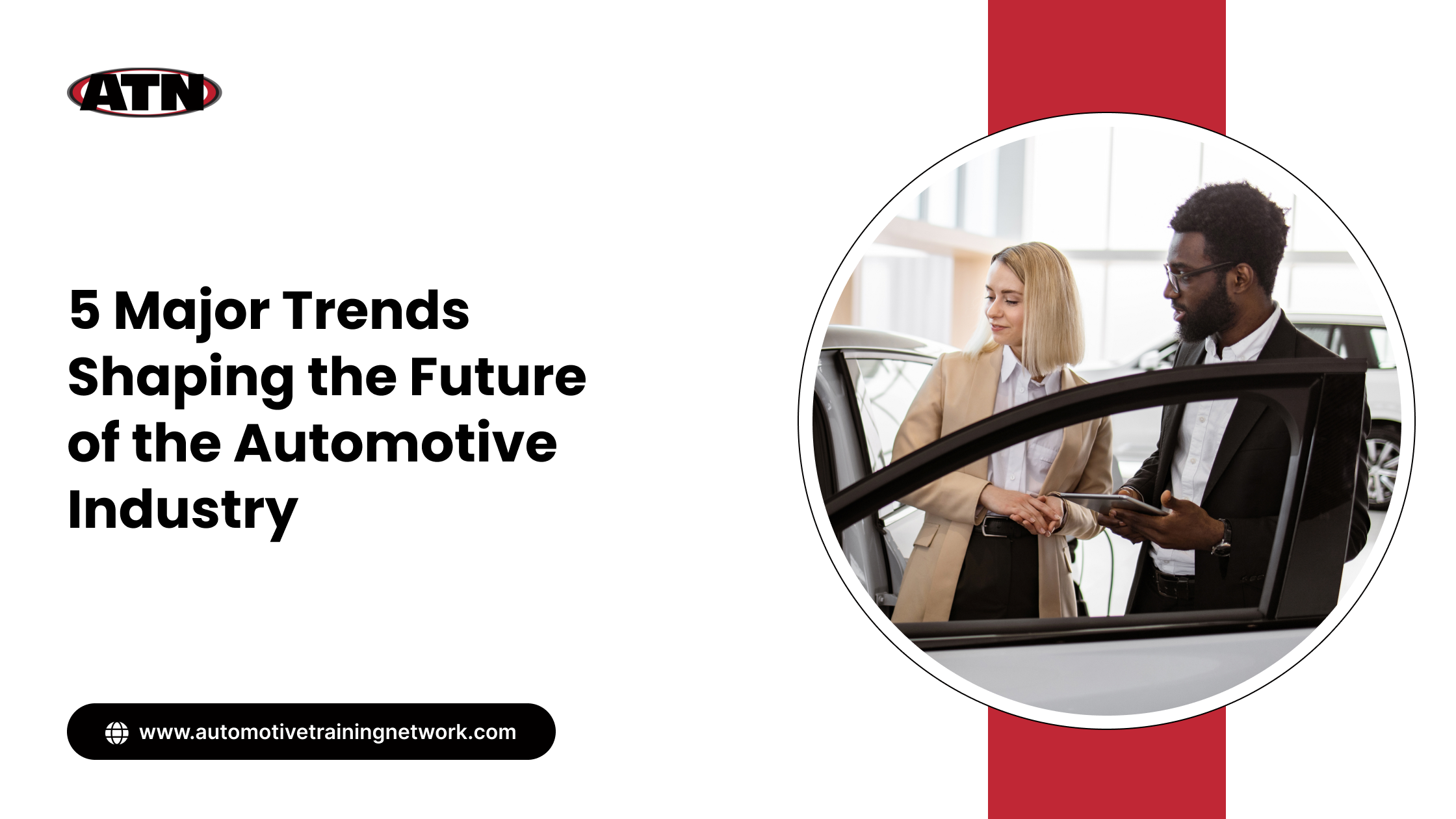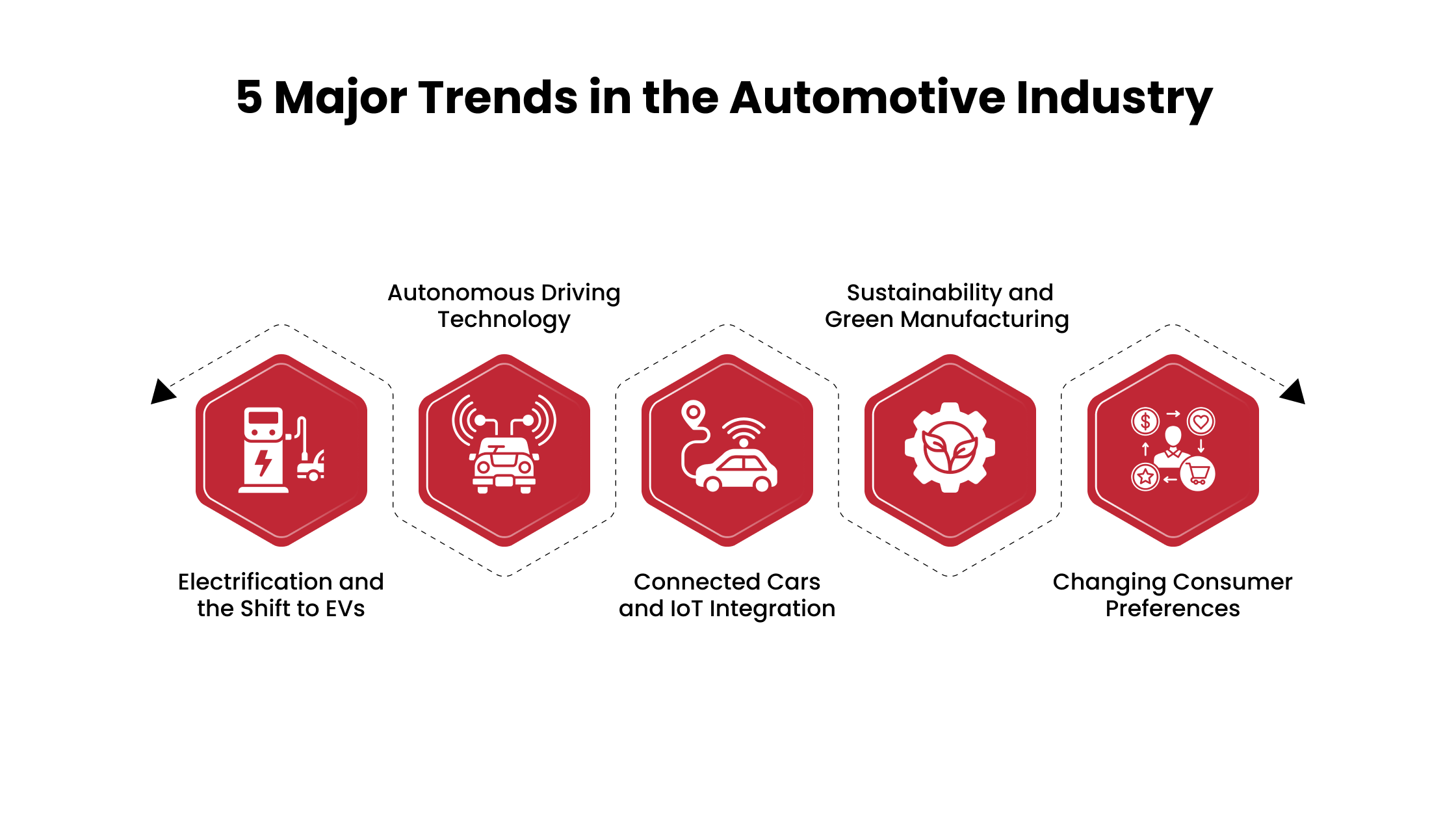5 Major Trends Shaping the Future of the Automotive Industry

According to reports, electric vehicles (EVs) will account for over 54% of all vehicle sales by 2040. This shift highlights how quickly the automotive industry is changing. The focus is no longer just on moving away from gas-powered cars. New trends like autonomous driving, connected vehicles, and green manufacturing are shaping the future of the automotive industry.
These changes bring both opportunities and challenges. While advancements promise cleaner, brighter, and more efficient transportation, businesses must adapt quickly.
So, what’s driving these changes? Let’s discuss the five major automotive future trends.
5 Major Trends in the Automotive Industry

The automotive industry is entering a phase of transformation driven by advancements in technology and shifting consumer demands. Automakers are rethinking old models, while new companies are entering the market with fresh ideas and innovative solutions. These changes reshape how vehicles are made, sold, and experienced, creating new opportunities and challenges across the sector.
1. Electrification and the Shift to EVs
Adopting electric vehicles (EVs) is reshaping the automotive industry as governments, automakers, and consumers align toward a greener future. In 2023, EV sales surged by 35%, driven by supportive policies, rising environmental concerns, and advancements in battery technology.
Countries like the UK, Germany, and several U.S. states have set ambitious targets to ban the sale of internal combustion engine (ICE) vehicles by 2035, pressuring automakers to prioritize electrification.
Growing consumer awareness about climate change and innovations in EV technology, such as longer ranges and faster charging, are making EVs increasingly attractive. Automakers are investing heavily to expand their EV lineups, recognizing the need to transition quickly to remain competitive.
Challenges to Overcome
Despite the rapid growth, there are some significant challenges for EVs. Charging infrastructure lags behind demand, and the supply chain for critical materials like lithium faces strain. However, partnerships between automakers, governments, and private sectors are actively addressing these issues to ensure a smoother transition.
The Impact on Automakers and Consumers
The shift toward electric vehicles significantly impacts both automakers and consumers. Companies like Tesla, Ford, and GM are expanding their EV lineups, recognizing the urgent need to transition to stay competitive and avoid obsolescence. With this shift, dealerships must refine their approach to cater to eco-conscious buyers. Learn how to enhance your dealership’s EV sales approach with these 10 Ways to Upgrade Your Automotive Sales Process.
For consumers, the growing availability of EV options means access to more affordable models with improved performance and range, making the transition to electric transportation increasingly appealing and accessible.
2. Autonomous Driving Technology
Autonomous driving technology is steadily progressing from concept to reality. Companies such as Tesla, Waymo, and General Motors’ Cruise are advancing efforts to develop fully self-driving vehicles, accelerating innovation in this area.
While full autonomy has not yet been achieved, Level 2 and Level 3 autonomous systems are already in use. These systems assist with steering, braking, and lane changes, though they still require human supervision. The long-term objective is to reach Level 5 autonomy, where vehicles operate entirely without human intervention.
What’s Causing the Expansion of Autonomous Vehicles?
AI and Machine Learning: Artificial intelligence (AI) and machine learning play a central role, enabling vehicles to process vast amounts of data, learn from real-world scenarios, and improve their performance over time. These algorithms are responsible for reliable and adaptive autonomous systems.
Sensor Technology: LIDAR, radar, and high-definition cameras allow vehicles to perceive their surroundings in real time, creating a detailed and dynamic understanding of their environment. These sensors work harmoniously to enhance safety and precision, which is critical for autonomous driving.
Consumer Demand for Convenience: Consumer demand also drives growth in this sector. Many drivers seek hands-free solutions to make long commutes more convenient, while businesses are exploring opportunities to utilize autonomous vehicles for delivery fleets and logistics.
Benefits of Autonomous Driving
Reduced Accidents: Most road accidents are caused by human error. AVs could drastically reduce fatalities.
Improved Efficiency: Self-driving cars can communicate with each other, optimizing traffic flow and reducing congestion.
New Business Models: Autonomous vehicles could pave the way for ride-hailing services, autonomous trucking, and delivery robots.
3. Connected Cars and IoT Integration
Cars are evolving into smart, connected devices powered by the Internet of Things (IoT). Modern vehicles can communicate with other cars, their environment, and even home systems. This connectivity enhances driving by improving safety, efficiency, and personalization. Connected cars use built-in internet connectivity to communicate with external systems. They can:
- Receive real-time updates on traffic, weather, and road conditions.
- Communicate with other vehicles to prevent accidents and reduce congestion.
- Sync with smart devices like phones, wearables, and home automation systems.
Examples of Connected Car Features
Connected cars are already offering features that enhance both safety and convenience:
In-Car Voice Assistants: Amazon Alexa Auto, Apple CarPlay, and Android Auto provide hands-free navigation, calls, and music control.
Over-the-Air Updates: Manufacturers like Tesla send software updates remotely, improving vehicle performance and adding new features without a dealership visit.
Predictive Maintenance: IoT sensors monitor the car’s condition and notify owners of potential issues before they become significant problems.
Vehicle-to-Everything (V2X) Communication: Cars can communicate with traffic lights, road signs, and other infrastructure to improve traffic flow and reduce accidents.
How Are Connected Cars Changing the Driving Experience?
Improved Safety
Collision warnings, blind-spot detection, and lane-keeping assistance are all possible due to IoT integration. In the future, connected cars will be able to communicate with each other to prevent accidents before they happen.
Personalization
Connected cars learn driver preferences, such as seat position, climate control settings, and favorite routes. Integration with smart home systems means your vehicle can turn on the lights or adjust your thermostat before you arrive home.
Entertainment and Convenience
Streaming services like Spotify, Netflix, and YouTube can be accessed directly from the car’s infotainment system. Cars can also pay for tolls, gas, or parking automatically through connected payment systems.
4. Sustainability and Green Manufacturing
The automotive industry prioritizes sustainability due to increasing consumer awareness, stricter regulations, and the urgency to address climate change. Automakers focus on producing more electric vehicles (EVs) while making manufacturing processes more environmentally friendly. This includes responsible sourcing of materials and improving vehicle recycling at the end of their lifecycle.
Consumers today are more eco-conscious. According to a survey, 64% of car drivers are sustainability-minded drivers. Additionally, governments worldwide are tightening emission regulations and encouraging manufacturers to adopt greener practices.
Automakers are committing to carbon-neutral goals and integrating sustainability into their operations. They’re increasingly using recycled materials like aluminum, plastics, and old vehicle parts to reduce waste. Renewable materials such as bio-based leather, natural fibers, and biodegradable plastics replace conventional materials.
Companies like BMW, Volvo, and Tesla are building carbon-neutral factories powered by renewable energy sources like solar, wind, and hydro. Ford’s Rouge Electric Vehicle Center aims to achieve carbon neutrality by using 100% renewable energy and zero-waste practices.
Benefits of Green Manufacturing for Automakers and Consumers
- Lower Carbon Footprint: Sustainable manufacturing helps automakers reduce greenhouse gas emissions and comply with stricter regulations.
- Cost Savings Over Time: Energy-efficient processes and waste reduction practices lead to lower production costs.
- Appeal to Eco-Conscious Consumers: A sustainable approach can boost brand loyalty and attract environmentally conscious buyers.
- Future-Proofing Against Regulations: Governments worldwide are implementing stricter emissions laws. Automakers that adopt green practices early will be better positioned for future regulations.
5. Changing Consumer Preferences
Many consumers no longer prioritize car ownership. Instead, they are increasingly inclined to choose flexible mobility solutions that align with individual lifestyles and budgets. The increasing popularity of car-sharing, ride-hailing, and subscription services is reshaping consumer perceptions of transportation.
This shift is prompting automakers to explore mobility-as-a-service (MaaS) offerings, altering traditional business models in the industry.
What’s Driving the Shift in Consumer Preferences?
Several factors are pushing consumers to rethink car ownership:
Urbanization and Traffic Congestion: Cities are getting more crowded, and owning a car in urban areas is becoming less practical due to traffic, parking costs, and environmental concerns.
Rising Costs of Car Ownership: Insurance, maintenance, fuel, and taxes make car ownership a costly investment. Many consumers prefer pay-as-you-go models like ride-hailing or subscriptions.
Sustainability Awareness: Younger generations are more focused on reducing their carbon footprint. They prefer shared mobility options over personal car ownership to help reduce emissions.
The Rise of Digital Platforms: The convenience of on-demand apps for transportation services (like Uber and Lyft) is making mobility more accessible and flexible.
Drive Your Dealership into the Future with ATN’s Proven Training Solutions
The automotive industry is constantly progressing. Staying ahead means understanding trends like EVs, autonomous driving, and shifting consumer preferences. But knowledge alone isn’t enough—you need the proper training to adapt your dealership’s approach and increase sales in this ever-changing market.
That’s where the Automotive Training Network (ATN) comes in. With 40+ years of experience, ATN helps dealerships improve performance and profitability through tailored training programs and consulting services. Our workshops equip your sales, BDC, and management teams with modern strategies that deliver results.
We offer customized training programs that address today’s industry challenges:
- Virtual Training: Interactive modules led by Tom Stuker to maximize learning outcomes.
- Bootcamps: 4-day in-person sessions focusing on overcoming objections, managing digital leads, and improving appointment-setting skills.
- In-Dealership Workshops: Tailored sessions for sales teams and managers to improve efficiency and customer satisfaction.
See how ATN can drive measurable growth for your dealership.
FAQs
1. How will the rise of electric vehicles (EVs) affect traditional car dealerships?
As EVs gain market share, car dealerships must adapt to selling and servicing electric vehicles. This could involve training staff on new technologies, investing in EV charging infrastructure and adjusting to changes in vehicle maintenance, as EVs have fewer moving parts than internal combustion engine cars. Dealerships must also stay competitive by offering more EV-related incentives and services.
2. What is the future of AI in the automotive industry?
AI will be crucial in automating production lines, improving vehicle design, and enhancing quality control. It will help automakers predict maintenance needs, optimize manufacturing processes, and enable more customized vehicle features based on consumer preferences. AI could also enhance safety features like predictive crash avoidance and driver assistance systems.
3. Will shared mobility and ride-hailing services replace car ownership in the future?
While shared mobility and ride-hailing services are growing rapidly, they may complement, not replace, car ownership for many consumers. In urban areas with good public transport, people may prefer on-demand ride-hailing. However, owning a vehicle will still be the most practical option in suburban or rural areas. The shift will depend on regional preferences, cost-effectiveness, and advancements in autonomous vehicles.